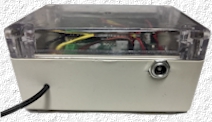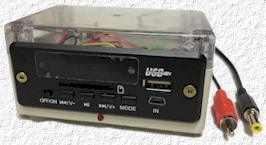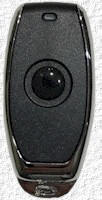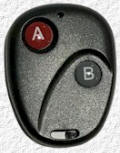|
Radio Extension Modules get more from your vintage radio
Click Here to See the Bluetooth Module in Action
Operating Instructions General Function The module can play in three modes, Bluetooth, FM and USB-SD Card (MP3 Player). The mode is changed by pressing the “Mode” button on the remote shown here. When using the Bluetooth Mode search for JQ-BT on your device to sync with the module. When a USB Key or SD Card is inserted the module will automatically change to the “MP3” Mode and start playing the first MP3 file on the Card or USB Key. When you select “FM Mode” for the first time press the “Pause-Play” button and the module will search for all FM stations in your location. This only needs to be done once since the stations are stored in the module’s memory. When completed it will return to the first FM station it detected. You can then use the “Forward” and “Back” buttons to scroll to your preferred FM station. Once selected, the module will return to that FM station each time the “FM Mode” is selected.
Download Complete
Operating Instructions Methods for Integrating the Module When it come to integrating the Radio Extension Module radios that were manufactured with a phono jack and Radio/Phono switch can be more easily modified relative to those that were not. Those without a phono jack require a relay to be installed to emulate the function of the Radio/Phono switch. This can be either a single relay taking the place of the Radio/Phono switch or a dual relay that also replaces the on/off switch. The Module requires a 9 to 12 volt power supply. This can come from a 9-volt battery, a rechargeable 12-volt battery, or a regulated 12-volt power supply. All of the options are illustrated in the diagram below. 12-volt Regulated Power Supply In this method a 12 volt regulated power supply is installed in the radio to provide power to the Radio Extension Module. In this case either the radio's radio/phono switch or remote relay is activated to change control from the radio to the module. In the case of the latter remote relays are installed in the radio that emulate the action of the radio/phono switch in radios that were manufactured with a phono jack at the back of the chassis.
|
||||||
|
Battery Powered Module This method involves either a 9-volt battery or a 12-volt rechargeable battery and is used for radios that were manufactured both with and without a Phono Jack and Radio/Phono switch. Given these options there are three configurations for battery powered Radio Extension Modultes.
Types of Modifications The Options above can be summarized into three types; Type A radios with a phono jack, Type B, radios without a phono jack with a single remote, and Type C, radios without a phono jack with dual remotes, Type A - for Radios with a Phono Jack The Type A Module is shown at the right. It is designed to be used with radios with a “Phono-Radio” switch It has a single audio plug used to send audio from the module to the Radio. To operate this module you must first plug the audio plug into the phono jack of the radio. Then turn the Radio-Phono knob on the radio to the Phono position. The Radio will now play programming from the module. The module can be powered by either a “9-volt” battery that is included in the module, or a Rechargeable 12-volt internal power unit. When the module depletes the “9-volt” battery it can be replaced by removing the top to the unit. In the case of the rechargeable power unit the unit must be recharged using the 12-volt charger provided. Simply insert the recharger into the power jack at the back of the module. The Type A module is available as an option with
the purchase of any radio with a built-in Phono jack and “Radio-Phono”
switch. |
||||||
Type B - for Radios without a Phono Jack and Single Remote The Type B Radio Extension Module shown here is designed for radios that were not manufactured with a “Radio-Phono” switch. These radios are modified, on request, to added a remotely controlled relay that emulates the function of the traditional “Radio/Phono” switch. As with the Type A the audio plug is inserted into the Radio’s Phono Jack. The power plug is inserted into the power jack on the back of the radio. Remote Operation
The Type B module can be added to any radio modified
- modification to the radio chassis is required. The Type B module
can be powered by a rechargeable power unit installed in the module
itself. Alternatively a 12 volt solid state regulated power supply can
be installed in the chassis of the radio to power the module. |
||||||
|
|
||||||
Type C - for Radios without a Phono Jack and Dual Remote The Type C Radio Extension Module shown here is designed for radios that were not manufactured with a “Radio/Phono” switch. These radios are modified, on request, to added a remotely controlled relay that emulates the function of the traditional “Radio/Phono” switch. A second remote relay can be added to enable you to turn the radio On and Off remotely. The Type C Module has two plugs; an audio plug and a power plug. As with the Type A the audio plug is inserted into the Radio’s Phono Jack. The power plug is inserted into the power jack on the back of the radio. Remote Operation
Button “B” on the Key FOB is used to switch between the normal radio AM Broadcast and the audio from the module. Button “B” has the same function as to traditional “Radio-Phono” switch on the radio.
The Type B module can be added to any radio modified
with remote relays. The cost to have a radio modified depends on the
complexity of the modification
All Type B modules come with rechargeable power units and chargers. |
||||||
|
|
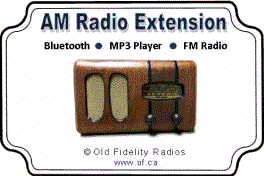 I thought it would be good if we could use our
vintage radios to do more that just listen to AM radio stations. We
could get much more use out of these antiques if we could use them
more often and if they could meet other needs we have in our lives such as
the occasion need for a Bluetooth speaker. It would also expand
their popularity, and therefore their preservation. the Radio Extension
Module allows radio owners to play a music playlist from their smart
phones, listen to FM stations or play music or old time radio programs
from a USB Key or SD Card. This module
lets you get so much more from your vintage AM Radio.
I thought it would be good if we could use our
vintage radios to do more that just listen to AM radio stations. We
could get much more use out of these antiques if we could use them
more often and if they could meet other needs we have in our lives such as
the occasion need for a Bluetooth speaker. It would also expand
their popularity, and therefore their preservation. the Radio Extension
Module allows radio owners to play a music playlist from their smart
phones, listen to FM stations or play music or old time radio programs
from a USB Key or SD Card. This module
lets you get so much more from your vintage AM Radio.


